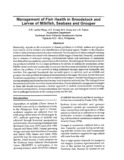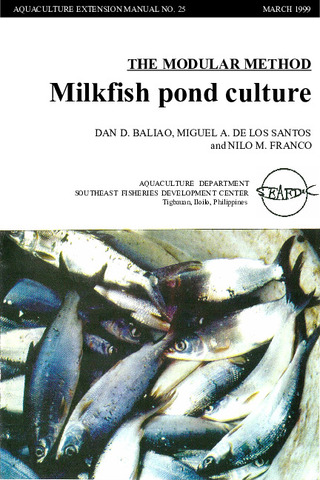Management of fish health in broodstock and larvae of milkfish, sea bass and grouper
- Global styles
- MLA
- Vancouver
- Elsevier - Harvard
- APA
- Help

View/
Date
1996Page views
6,881ASFA keyword
AGROVOC keyword
Taxonomic term
Metadata
Show full item record
Share
Abstract
Historically, reports on the occurrence of disease problems in milkfish, seabass and grouper were mainly on the isolation and identification of etiological agents. Studies on the tolereance of fish to chemotherapeutants were also conducted. Various species of vibrios and gill-infesting parasites have been associated with diseases in all life stages of these fish. Presently, mortalities due to diseases of unknown etiology, environmental failure and nutritional or husbandry shortfalls affect successful fry production in the hatchery. Morphological deformities in hatchery-produced milkfish fry is a major problem to be solved. In seabass fry production, swim-bladder stress syndrome occasionally occurs and results in mass mortalities. In larval grouper culture, the problem of low survival is being addressed through improved husbandry and nutrition. For cage-held broodstock that naturally spawn in captivity, such as milkfish and grouper, the main problem is fouling of net enclosures in the cages. However, for fish that need hormonal manipulation to spawn, such as seabass and snapper, stressful handling procedures during sampling and hormone injection may lead to injuries and scale loss. The damaged areas become focal points for secondary bacterial infection. Future fish health management strategies in these fish should incorporate a holistic approach to include environmental monitoring, nutritional manipulation, immunostimulants and vaccine use, and biological control in addition to pathogen exclusion in the rearing system and the fish.
Suggested Citation
Lavilla-Pitogo, C. R., Emata, A. C., Duray, M. N., & Toledo, J. D. (1996). Management of fish health in broodstock and larvae of milkfish, sea bass and grouper. In K. L. Main & C. Rosenfeld (Eds.), Aquaculture health management strategies for marine fishes?: proceedings of a workshop in Honolulu, Hawaii, October 9- 13, 1995 (pp. 47-56). Walmanalo, Hawaii: The Oceanic Institute.
Type
Conference paperISBN
1886608024Collections
- Conference Proceedings [299]
Related items
Showing items related by title, author, creator and subject.
-
Series: Aquaculture extension manual; No. 25
The modular method: Milkfish pond culture
Baliao, Dan D.; de los Santos, Miguel A.; Franco, Nilo M. (Aquaculture Department, Southeast Asian Fisheries Development Center, 1999)The modular method of milkfish culture (Chanos chanos) described in the manual is an improvement over the traditional extensive method. The manual is intended for the use of fish farmers and aquaculturists, extensionists, ... -
Evaluation of organic and inorganic fertilizers in brackishwater milkfish ponds
Bombeo-Tuburan, Isidra; Agbayani, Renato F.; Subosa, Precilla F. (Elsevier, 1989)The study was conducted in twelve 144-m2 ponds to evaluate the effect of different organic and inorganic fertilizers on the growth, survival, gross production, and profitability of marketable milkfish. The ... -
Milkfish breeding and hatchery technology at SEAFDEC/AQD
Unknown author (Aquaculture Department, Southeast Asian Fisheries Development Center, 1999)Describes the techniques already adopted by the private sector: broodstock management, broodstock diet, commercial fry production, live transport, and larval diet. A list of AQD research publications on milkfish is included.





